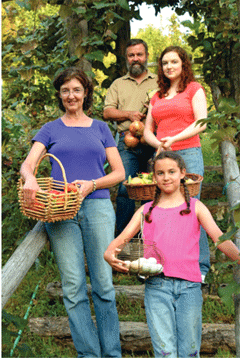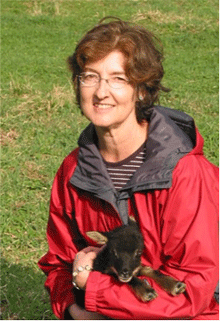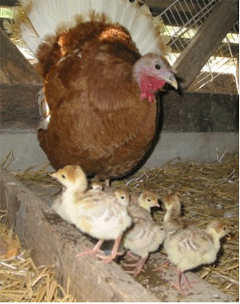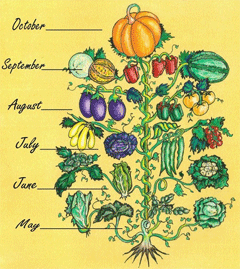Life As a Locavore
Air Date: Week of July 25, 2008

Barbara Kingsolver and family. (Photo: Hank Daniel)
Author Barbara Kingsolver recounts eating locally grown food for a year in the book “Animal, Vegetable, Miracle: A Year of Food Life.” She talks to Steve Curwood about why food has become a public issue, the challenges of finding local food year-round, and how the commitment ultimately changed her family.
Transcript
CURWOOD: Barbara Kingsolver left life in the farm country of Kentucky in the 1970s to become educated as an evolutionary biologist. But what she didn’t know was that she would also become a best-selling novelist. You may know some of her titles: “The Poisonwood Bible” is one “Prodigal Summer” is another. Now she and her husband and daughter have a volume that documents how her family carried out a vow to eat only locally grown food for one year. The book is called “Animal, Vegetable, Miracle; A Year of Food Life.” Her family produced about seventy percent of what went on their table from their own farm in Virginia—everything from tomatoes to turkeys.

Barbara Kingsolver and a lamb born on her Virginia farm. (Courtesy of Barbara Kingsolver)
KINGSOLVER: We were led into this project for so many reasons. For me, it’s because I grew up in a rural community among farmers and I’ve always considered the local farming economy to be important and frankly an important part of food security. We are now, as a nation, putting almost as much fossil fuels into our refrigerators as our cars. Every item on average on the American plate has traveled 1500 miles so add up all the items on your plate and you might as well order room service from the moon!
That’s an incredible amount of fossil fuel, an incredible amount of carbon emissions going into the atmosphere, warming up the globe just to get a grape from Chile, a tomato from Mexico so I can eat a tomato in January.
CURWOOD: Now, you write in your book that 80 percent of us in America would love to eat organic and locally grown foods yet the American government through the farm bill gives just about all federal money to the biggest farms in the country and most of them grow things like corn, soybeans, and wheat far from where most of us live. Can you talk to me more about that?
KINGSOLVER: I’m so glad you brought that up. U.S. taxpayers pay tens of billions of dollars every year to subsidize the production of commodity crops which are, as you mentioned, mostly corn wheat and soybeans. Most of that production enters our diets without our notice as the ingredients of processed foods like high fructose corn syrup and feed to raise cattle and hogs. And we also as taxpayers subsidize the fuel costs of getting these products manufactured and shipped to the market.

Kingsolver keeps a breeding flock of rare heritage Bourbon Red turkeys. (Courtesy of Barbara Kingsolver)
CURWOOD: About what did it cost you to grow your own food and buy the rest of it locally?
KINGSOLVER: You know what, we were stunned by the answer to that question. I kept really careful records and I found out that we spent about 50 cents per person per meal to eat as splendidly as we did in this year. And I thought this must be a mistake so I went back and I recalculated and that was it: 50 cents per person per meal.
CURWOOD: So, for those of us that are used to having orange juice for breakfast, how were you able to pull this off? I mean eating locally, growing it yourself or getting it from local farmers means for example you’re not going to have orange juice for breakfast there in Virginia.
KINGSOLVER: You start by accepting this will be a paradigm shift. This will be a change in the way you think about food and as time went by we really learned to stop asking the question, what do I want right now? And instead start seeing each week as something like the menu in a restaurant: Look at what’s available. What do they have? What’s growing this week? What’s fresh and delicious and choose from that.

The “vegetannual,” a term invented by Barbara Kingsolver to describe when fruits and vegetables are in season. (Courtesy of Barbara Kingsolver)
CURWOOD: Now you were a vegetarian for many years but as part of this project you decided to raise and slaughter your own meat. Talk to me about how and why you came to that decision.
KINGSOLVER: It’s really important to know that food is not just a product but a process. There are two very different ways of producing meat. One of them is concentrated animal feeding operations or CAFOs. These are feed lots for cattle or metal windowless warehouses for hogs, turkeys, chickens and so forth where they’re crowded as close as they possibly can be and these very concentrated populations require that all of their food be milled and processed somewhere else and brought in and then all of the concentrated waste have to be trucked out to somewhere, heaven only knows where. And these animals get fed this porridge of the cheapest ingredients just for the efficiency of producing cheap meat. And also they have to be given antibiotics in order to keep them alive under conditions of extreme physiological stress. So that kind of meat I hadn’t eaten for many years.
There is another way, a different way of raising meat, and that is keeping these animals on pasture. And the interesting thing from an energetic point of view is that they can do all this without using a drop of gasoline. In the county where I live we have a lot of steep grassy pastures. And we can use this as a solar-powered industry to make meat. And that’s the food that my grandparents got through the winter on and we felt that we could do the same and we even raised turkeys and chickens of our own.

Barbara Kingsolver and family. (Photo: Hank Daniel)
KINGSOLVER: Yeah.
CURWOOD: And you’d only been at this a little while. I mean you didn’t have last year’s canned goods or anything stuck in your freezer that you could trot out here.
KINGSOLVER: Right. We began thinking this is a pretty bleak time of year. May is still pretty early where we live in the mountains of southern Appalachia. There’s not a lot coming up just yet. And we were thinking, oh this is going to be the borsht party beets and potatoes. But as a matter of fact as happened over and again in this project, what we found was so much more than we were looking for. There were terrific salad greens. There were asparagus there were eggs so we could have asparagus frittatas. There was rhubarb and strawberries so we could have strawberry rhubarb crisp. There were lamb and oh wow we had chicken pizza. There was so much that was just literally down the road from where we lived, so much more than we expected. And it turned out to be a terrific event because it reinforced to us this isn’t a story of deprivation. This is a story of gratitude.
CURWOOD: Now, where you are in Virginia, you’ve got a farm, a lot of neighbors who are in the food business. But what about somebody who lives in say the city or say a colder climate. What kind of advice would you offer for taking steps to eat more locally?
KINGSOLVER: Being thoughtful about food life is not of course about growing your own. Anyone who has choices about food can exercise them with more care even in the cities and especially in the cities. Every grocery store that carries multiple brands will have some that are produced closer to home than others. We can all emphasize whole ingredients more and pass up processed goods that have so many hidden costs. And the next stop of course is the farmer’s market. More than half of all of us living in the US live within striking distance of a place where farmers sell their own produce. Also many cities have community gardens. I think there are 114 of them in Manhattan alone. Any way you cut it getting to know your own food chain is neighborly and it’s healthy. It keeps your money in your own community and it keeps the land around you a little more green.
CURWOOD: So you eat locally for a year and you lived to tell about it and the day this project was finished did you run out for what uh maybe uh…
KINGSOLVER: Coca Cola and moon pies? No, we didn’t. We forgot to notice the day the project ended. By this time it was just the way we lived. We have a new relationship with where we live. We are what we ate.
CURWOOD: Barbara Kingsolver’s new book is Animal, Vegetable, Miracle; a Year of Food Life. It was written with her husband Steven L. Hopp and daughter Camille Kingsolver. Barbara, thank you so much.
KINGSOLVER: Thank you, bye.
Links
For recipes and a tour of the farm, click here
To find community-supported agriculture in your area click here
Living on Earth wants to hear from you!
Living on Earth
62 Calef Highway, Suite 212
Lee, NH 03861
Telephone: 617-287-4121
E-mail: comments@loe.org
Newsletter [Click here]
Donate to Living on Earth!
Living on Earth is an independent media program and relies entirely on contributions from listeners and institutions supporting public service. Please donate now to preserve an independent environmental voice.
NewsletterLiving on Earth offers a weekly delivery of the show's rundown to your mailbox. Sign up for our newsletter today!
 Sailors For The Sea: Be the change you want to sea.
Sailors For The Sea: Be the change you want to sea.
 The Grantham Foundation for the Protection of the Environment: Committed to protecting and improving the health of the global environment.
The Grantham Foundation for the Protection of the Environment: Committed to protecting and improving the health of the global environment.
 Contribute to Living on Earth and receive, as our gift to you, an archival print of one of Mark Seth Lender's extraordinary wildlife photographs. Follow the link to see Mark's current collection of photographs.
Contribute to Living on Earth and receive, as our gift to you, an archival print of one of Mark Seth Lender's extraordinary wildlife photographs. Follow the link to see Mark's current collection of photographs.
 Buy a signed copy of Mark Seth Lender's book Smeagull the Seagull & support Living on Earth
Buy a signed copy of Mark Seth Lender's book Smeagull the Seagull & support Living on Earth

